
| Version | Summary | Created by | Modification | Content Size | Created at | Operation |
|---|---|---|---|---|---|---|
| 1 | Beatrix Zheng | -- | 4959 | 2022-11-30 01:47:09 | | | |
| 2 | Beatrix Zheng | Meta information modification | 4959 | 2022-12-02 09:06:57 | | |
Video Upload Options
The examination of Apollo Moon photographs is an endeavour undertaken by certain people engaged in the debate as to the merits of Moon landing conspiracy theories, despite the abundance of third-party evidence for Apollo Moon landings. A number of allegations and refutations with a variable degree of notability are put forward due to this examination.
1. Allegations and Refutations
1.1. Absence of Stars
Conspiracy theorists (henceforth conspiracists) frequently point out that there are no stars in the Apollo photographs.[1] Cosmonaut Yuri Gagarin, the first human to travel in outer space in 1961, commented that the stars seen from his Vostok spacecraft were "bright and clear cut."[2] Conspiracists contend that NASA chose not to put the stars into the photos because astronomers would have been able to use them to determine whether the photos were taken from the Earth or the Moon, by means of identifying them and comparing their celestial position and parallax to what would be expected for either observation site.
-

STS088-719-59: 70 mm Hasselblad photograph of Zarya from the Space Shuttle Endeavour during STS-88 (December 6, 1998). No stars visible. https://handwiki.org/wiki/index.php?curid=1495966
-

STS091-711-028: No stars visible in a 70 mm Hasselblad photograph of the Moon and Mir from the Space Shuttle Discovery during STS-91 (June 8, 1998). https://handwiki.org/wiki/index.php?curid=1646773
-
- Stars are sometimes seen in International Space Station videos and photographs taken while the ISS is on the night side of the Earth.[3] Stars are rarely seen in Space Shuttle, Mir, Earth observation photos, or even sporting events that take place at night. The light from the Sun in outer space in the Earth-Moon system is at least as bright as the sunlight that reaches the Earth's surface on a clear day at noon, so cameras used for imaging subjects illuminated by sunlight are set for a daylight exposure. The dim light of the stars simply do not provide enough exposure to record visible images. (This effect can be demonstrated on Earth by attempting to view stars from a brightly lit parking lot at night. Only a few of the brightest stars are visible, and shielding the eye with one's hands only marginally improves the view. Science fiction films and television shows do confuse this issue by depicting stars as visible in space under all lighting conditions. A photographic demonstration of how aperture and shutter speed can turn a lit background ink-black is here. The eye's visual response is much the same.) Stars were seen by every Apollo mission crew except for Apollo 13. (An oxygen tank explosion in the Apollo 13 Service Module two days after launch prevented the crew from clearly seeing stars due to a haze of oxygen and water vapor surrounding the spacecraft.) Stars were used for navigation purposes and were occasionally also seen through cabin windows when the conditions allowed. To see stars, nothing lit by sunlight could be in the viewer's field of view.[4]
-
- Payload restrictions made the transport of telescope facilities to the Moon unfeasible, and without these ordinary stellar photography would have served no (scientific) purpose. However, even without such facilities, the Moon does offer several advantages as an observation platform. The near-absence of a lunar atmosphere means that stellar imaging is possible at many wavelengths which are not visible from Earth. Long-exposure photos were taken with a special far ultraviolet camera, the Far Ultraviolet Camera/Spectrograph, by Apollo 16 astronauts from the surface of the Moon, and operated in the shadow of the Apollo Lunar Module (LM). (The second photo on the lower right has some stars labeled.) Some of these photos show the Earth with stars from the Capricornus and Aquarius constellations in the background. The European Space Research Organisation's TD-1A satellite later scanned the sky for stars that are bright in ultraviolet light. The TD-1A data obtained with the shortest passband is a close match for the Apollo 16 photographs.[5]
-
- The planet Venus (which is much brighter than any of the stars) was actually recorded on film by astronaut Alan Shepard at the conclusion of his second extra-vehicular activity (EVA), during the Apollo 14 mission. Shepard was preparing to ascend the ladder to re-enter the Lunar Module Antares, when he likely noticed Venus shining brightly next to the crescent Earth. He made a series of photographs with his chest-mounted Hasselblad camera, likely all at 1/250th second exposure, and differing f-stops. Owing to its position closer to the Sun and its complete coverage by clouds, Venus has a higher surface brightness than Earth, and is indeed visible to the unaided eye in broad daylight from Earth, given a sufficiently transparent sky. It would have been plainly visible to Shepard in the lunar sky, and easily recorded on film. For a complete explanation, consult the Apollo Lunar Surface Journal's "Venus over the Apollo 14 LM."[6]
-
- Later Apollo missions used Nikon F 35 mm cameras with a special f/1.2 aperture 55 mm lens in order to take photographs in low light conditions of the solar corona, Zodiacal light and other phenomena that are difficult to photograph in a terrestrial Environment. Two of Apollo 16's magazines are available on this website. Several of the photographs feature identifiable stars and planets. The bright star on the left margin of this image, for example, is Sirius, this image features the southern cross, and this one shows Venus, Mars and (hidden in the glare by the window frame) Saturn. Apollo 16's Magazine SS has Hasselblad 70 mm photographs of stars in the Solar Corona.
-
- In an August 12, 1969, Apollo 11 post-flight press conference, astronaut Neil Armstrong states, "We were never able to see stars from the lunar surface or on the daylight side of the Moon by eye without looking through the optics."[7][8] Stars were visible with the naked eye only when they were in the shadow of the Moon. All of the landings were in daylight.[9]
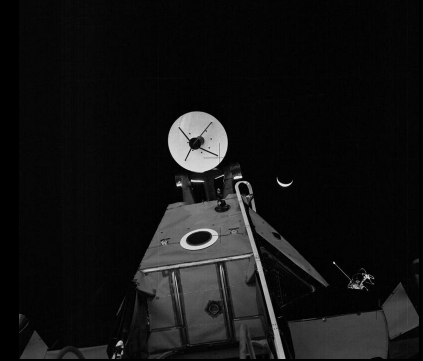

1.2. Inconsistent Color and Angle of Shadows and Light
The shadows should be absolutely black and run parallel to each other.[10]
-
- Shadows on the Moon are complicated because there are several light sources: the Sun, and the Earth, as well as the astronauts and the Lunar Module.[11] Light from these sources is scattered by lunar dust in many different directions, including into shadows. Additionally, the Moon's surface is not flat and shadows falling into craters and hills appear longer, shorter and distorted from the simple expectations of the conspiracists. More significantly, perspective effects come into play, particularly on rough or angled ground.[12] This leads to non-parallel shadows even on objects which are extremely close to each other, and can be observed easily on Earth wherever fences or trees are found. And finally, the camera in use was fitted with a wide angle lens, which naturally resulted in subtle versions of fisheye lens distortion.[13]

The photographer's shadow should point to his position which is straight below the centre of the bottom edge of the photo.[14][15]
-
- No explanation is given as to why the photographer's feet must be below the centre of the photograph. Indeed, many photographs show this to not be the case.[16]
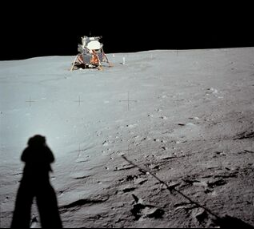
1.3. Apparent "Hot Spots" in Some Photographs
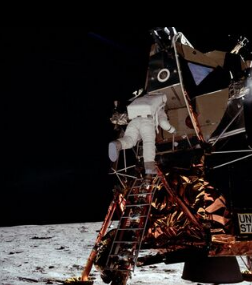
Conspiracists claim that the classic photo of Apollo 11 astronaut Buzz Aldrin on the Moon (AS11-40-5903) looks as if a huge spotlight was used at a close distance.[17] Jan Lundberg, an engineer at Hasselblad responsible for producing the photographic cameras used for the Apollo missions, stated: "Yes, it seems like he is standing in a spotlight and I can't explain that. Umm, that escapes me why. So maybe you have to find Armstrong and ask him!"[18]
-
- The illumination of the Aldrin photograph referred to by Lundberg is an artifact of altering the brightness and contrast of the image, and it is not found in all reproductions. This can be seen in the next section, where this photograph is shown in two versions.
- Lunar dust reflects light in a manner similar to street signs or wet grass – a significant amount of light is reflected back at the light source (the Sun in this case) instead of being scattered in all directions as Earth sand would do.[19] This can be observed on Earth, as it explains why the full Moon is much more than twice as bright as a half Moon.[20] This effect explains hot spots in photos that contain the photographer's own shadow.
- The sunlit portion of Armstrong's spacesuit is in the correct place to provide the light for the hotspot in the photo of Aldrin on the ladder.
- The "hot spots" are discussed at the debunking website Moon Base Clavius (Clavius.org).[21]
In an Apollo 12 voice recording during the mission's first EVA, astronaut Pete Conrad said: "Boy, that Sun is bright. That's just like somebody shining a spotlight in your hand." [...] "I'll tell you...You know, this Sun...It really is...It's just like somebody's got a super-bright spotlight."[22][23]
-
- Conrad is only describing the brightness of the sunlight on the Moon.
1.4. Issues with Crosshairs in Photographs
There are some issues with the appearance of crosshairs in the photographs; these are present in the image as a result of a Réseau plate incorporated into the cameras.
-

AS11-40-5931: 1998 scan. https://handwiki.org/wiki/index.php?curid=1356823
-
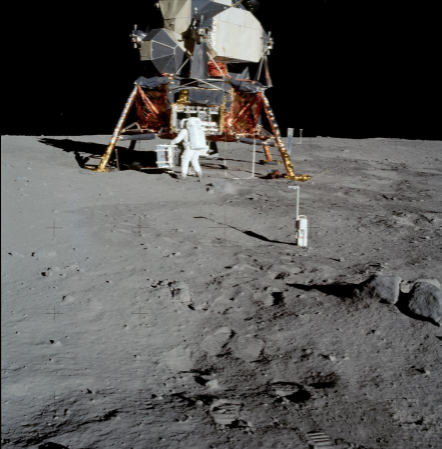
AS11-40-5931: 2004 scan. https://handwiki.org/wiki/index.php?curid=1747547
-

AS11-40-5931: 1998 scan enlargement – crosshair bleeds out. https://handwiki.org/wiki/index.php?curid=1191574
-

AS11-40-5931: 2004 scan enlargement – crosshair visible. https://handwiki.org/wiki/index.php?curid=1326822
- a) In some photos, the crosshairs (fiduciary markers) appear to be behind objects, rather than in front of them where they should be, as if the photos were altered.[24] In photography, the light white color (the object behind the crosshair) makes the black object (the crosshair) invisible due to saturation effects in the film emulsion. The film particles that ought to have been black were exposed by light from the adjacent brightly lit particles.[25] Ironically, this saturation effect would not happen if the crosshairs were drawn on in post, and so is evidence of genuine photos. Attempting to alter photos that already have crosshairs would make the compositing process far more difficult.
- b) In the classic photo of Aldrin on the Moon below (at left), the reticle (etched crosshair on the camera) is too low. Since the crosshairs are in a fixed position on all the images, a lower reticle on this image indicates that the image has been cropped. This is the case even on the 70 mm duplicate transparency NASA issues. The 70 mm transparencies should show the entire 'full' image. Conspiracists say that the only explanation for this is if the original full transparency needed to be cropped because of an embarrassing artifact like a piece of stage scenery was in the shot.[24]
-
- The view of the actual photo below (at right) (source: AS11-40-5903 or AS11-40-5903 high resolution) is chopped off just above Aldrin, cutting off Aldrin's antenna (except for a small piece). Duplicate transparencies are not necessarily exact copies of the original. The publicly released version of the photo was cropped and recomposed by NASA within hours of the film being made available, with extra black space added at the top of most released versions for what NASA calls aesthetic reasons. This web page has NASA's history of the photo.


- c) In other photos, the reticules are not in a straight line, or appear in the 'wrong' place, indicating that the photo has been doctored.[26]
-
- Clavius.org explains that the methodologies that the conspiracists propose for doctoring the photos with "wrong" reticules are often contradictory and generally require absurd lengths to explain the "inconsistencies" when there are reasonable explanations. In particular, prints were often cropped and rotated, which causes the illusion of reticules occurring off-center or "not straight."[24]


1.5. Apparently Identical Backgrounds in Apollo 15 Photographs Taken at Different Locations
There are issues with Apollo 15 photos having identical backgrounds.

center|thumb|AS15-82-11082: Later photo with same hills in the background near Hadley Rille (Station 9) during the third EVA, approximately 1.4 km west of the Lunar Module.[27]
-
- Detailed comparison of the backgrounds said to be identical in fact show significant changes in the relative positions of the hills that are consistent with the claimed locations that the images were taken from. Parallax effects clearly demonstrate that the images were taken from widely different locations around the landing sites.
-
- Claims that the appearance of the background is identical while the foreground changes (for example, from a boulder strewn crater to the Lunar Module) are trivially explained when the images were taken from nearby locations, akin to seeing distant mountains appearing the same on Earth from locations that are hundreds of feet apart showing different foreground items.
-
- Furthermore, as there is only an extremely tenuous atmosphere on the Moon, very distant objects will appear clearer and closer to the human eye. What appears as nearby hills in some photographs, are actually mountains several kilometers high and some 10–20 kilometers away. Changes in such very distant backgrounds are quite subtle, and can be mistaken for no change at all.
-
- As the Moon is also much smaller than the Earth, the horizon is significantly nearer in photographs than Earthbound observers are used to seeing (an eye 1.7 m above completely flat ground will see the horizon 4.7 km away on Earth, but only 2.4 km away on the Moon). This can lead to confusing interpretations of the images.[28]
-
- One specific case is debunked in "Who Mourns For Apollo?" by Mike Bara.[29]
-
-
- While it is true that there is no haze to assist in judging distance, the maximum distance to the horizon is much closer than on Earth, due to the smaller size of the Moon. This limits the scope for the same objects to appear in different shots taken at different locations.
-
-
-
- For a flat area of the Moon, the distance to horizon ≈ sqrt ( 2 * radius of Moon * height of observer )[30]
-
-
-
- The Moon's average radius is 1,080 miles, and assuming generously that the astronauts held the camera 5 feet, or 0.000947 miles above the surface (the cameras are shown in photographs as having no viewfinder, and the astronauts seem to hold them in the centre of their chest, so five feet is generous).
-
-
-
- These figures give distance = sqrt (2 * 1080 * 0.000947) = 2 miles.
-
-
-
- It seems that this would be far enough for terrain features to appear in shots taken from locations some distance apart, but perhaps not "miles apart." Without having specific information as to which shots and the terrain they are purported to contain, there is no definite answer.
-
1.6. High Number of Photographs
When the number of photographs taken by astronauts during the EVAs of all Apollo missions is divided by the duration of all of the EVAs, one arrives at a figure of 1.19 photos per minute. That is one photo per 50 seconds. Discounting time spent on other activities results in one photo per 15 seconds for Apollo 11. This is even more remarkable because many places in the photographs are miles apart and would have taken considerable travel time to reach, especially in bulky pressure suits. Moreover, the cameras were equipped with neither a viewfinder nor automatic exposure control, which means that taking good pictures would take considerably longer.[31]

-
- The astronauts were well trained in photography before the mission. Because there was no weather to contend with and the bright sunlight allowed the use of small apertures, with consequent large depth of field, the equipment generally was kept at a single setting throughout the mission. All that was needed to take a picture was to open the shutter. Film winding was automatic.
-
- In these conditions it is possible to take two photographs per second at best. The camera was in a bracket mounted on the front of their spacesuit, so they looked straight ahead at what they wanted to photograph; no viewfinder was needed. Also, many of the photographs were stereoscopic pairs or sets of panoramic images, taken immediately after each other. The Lunar and Planetary Institute's Apollo Image Atlas shows that 70 mm magazine 40/S of Apollo 11 has 123 photos taken during the walk on the surface—less than one per minute.[32] In addition, by looking at the photographs in sequence, one can see that very often several of them were taken in rapid succession. Here is a list of Apollo 11 surface photos (AS11-40-5850 to AS11-40-5970). As can be seen from the map, many photos were taken from a similar position.
1.7. Quality of the Photographs
Given the lack of time and viewfinders, the photos look much better than would be expected, with perfect focus and exposure, a charge made by Ralph René.[33]
-
- The astronauts were trained in the use of their gear, and shots and poses were planned in advance as part of the mission. NASA selected only the best photographs for release to the public, and some of the photos were cropped to improve their composition. There are many badly exposed, badly focused and poorly composed images amongst the thousands of photos that were taken by the Apollo astronauts. All photos taken on the surface of the Moon by the astronauts can be seen at the Apollo Lunar Surface Journal. Photos were taken on high-quality Hasselblad cameras with Zeiss lenses, using 70 mm medium format film.[34]
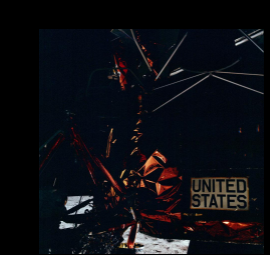

1.8. Photographs Containing Artifacts
There are artifacts in the photos such as the two seemingly matching 'C's on a rock and on the ground (the rock is seen in NASA photos AS16-107-17445 and 17446). They could be "prop continuity markers." Conspiracists say that the first copies of the photos released do show these marks, and that later releases may have been doctored, and that attempts to debunk this problem focus exclusively on one example on the rock, ignoring the second on the ground and the coincidence of two, allegedly identical artifacts on the same photo.[35]
-
- The "C"-shaped objects are most likely printing imperfections not in the original film from the camera, but only in some of the later generation copies of AS16-107-17446 (and no copies of 17445). One suggestion, as seen in the next link, is that when magnified the 'C' is a coiled hair present on a specific print of the photo which was later widely duplicated. (See "Who Mourns For Apollo?"[29] by Mike Bara and "Clavius: Photo Analysis - lunar rover" by Jay Windley.[36])
-

Original AS16-107-17445 photograph. https://handwiki.org/wiki/index.php?curid=1466229
-

Original AS16-107-17446 photograph. https://handwiki.org/wiki/index.php?curid=1847197
-

Close up of later generation prints of AS16-107-17446, showing the "C". https://handwiki.org/wiki/index.php?curid=1431704
1.9. Artifacts in the Film
A resident of Perth, Australia, a woman named Una Ronald (a pseudonym created by the authors of the source[37]), said that for two or three seconds she saw a Coca-Cola bottle roll across the lower right quadrant of her television screen that was displaying the live broadcast of the Apollo 11 EVA, and believed the rolling bottle was edited out of later playbacks of the footage. She also said that several letters appeared in The West Australian discussing the Coca-Cola bottle incident within ten days of the lunar landing. Western Australia was the only place in the world that received their feed live without delay.[38][39]
-
- It is true that Australia n viewers saw the footage first, as the downlink was to several radio-telescopes in New South Wales, including Parkes Observatory.[40] But the lead over Houston's transmission was only 6 seconds. Not enough time to do a convincing superimposition of a bottle being kicked by an astronaut, and not enough time to convincingly remove a bottle kicked by an actor, even with today's technology, and even if the operator was prepared in advance.
-
- Transmissions from the Moon required video signals of very different design than that of ordinary television, and were converted to standard video by pointing a camera at a video screen, a process known as kinescope[40]—similar to the predominant method of recording television in the day—to 16 mm film, not to videotape, which was expensive and cumbersome.[41] The process is vulnerable to added reflections between the monitor glass and the camera lens. "Ghost" mirror images of highlights appear throughout the recordings of the broadcast video and are undoubtedly a result of this process.[42] Such artifacts were noticed at the time by the operators, though some of them may have been introduced in the recording of the broadcast, rather than during the preparation for broadcast.
-
- An MPEG video segment available directly from NASA, said to be of the exact footage in question,[43][44] does indeed show artifacts which correspond to ghosting occurring—although none obviously resemble any type of bottle. Indeed, with the quality of the recording available, spotting a stray bottle on the "set" is a hard task, even when told what to look for, where and when.
-
- A Clavius.org researcher, Peter Barrett,[45] who examined archival copies of the editions of the paper surrounding this time, was unable to find any evidence of published discussions described by Ronald. Likewise, chief librarian Tracey Bennett for The West Australian confirmed that for at least two weeks following the Apollo 11 moonwalk, the paper published no accounts of a Coke bottle being seen in the broadcast.[39]
-
- Ronald's claims have only been relayed by one source.[46]
-
- According to the one source,[47] Ronald distinctly mentioned that she had to stay up late to watch the Moon landing live. This may indicate that she is an invention of someone who is not from Australia, or is someone who has little knowledge of the Moon landing, as those who did watch the Moon landing live in Australia usually recall that it occurred in the middle of the Australian day.[39][48]
-
- It would be technically incorrect to say that Western Australia received the footage "before the rest of the world," since this discounts the remainder of Australia. So if that is what was claimed in the original source for the claim, then that is one more glossing-over of the specific details of the event, which does not count in their favour, and demonstrates an actual lack-of-familiarity with Australia.
-
- Parkes puts the time of the broadcast at 12:54 p.m., and Western Australia is two hours behind Australian Eastern Standard Time, so any live broadcast would have been received there at around 11 a.m. local time. (Daylight saving time is not active in the Southern Hemisphere in July when the Moon landing took place, so the calculation is simplified.) So assuming Ronald did indeed watch her broadcast late at night, then logically the reason her footage differed from that seen by the rest of the world must have been that it had been doctored between the time of the live broadcast when most of the world failed to observe anything unusual, and her later viewing some kind of delayed broadcast[39] (none is known to have taken place, but the possibility is hard to rule out).
-
- However, it is not difficult to verify that videotape technology was not widely available in 1969, and was bulky, expensive and required specialist knowledge to operate.[41][49] Film was still the predominant storage medium, even for professional archiving of television broadcasts.[40] Altering a videotape would require access to prized equipment, which would be unlikely to be available to the casual practical-joker, even if they had the ability to operate it so well.
1.10. Publication of a Clearly Altered Photograph
The 1994 hardcover version of Moon Shot by Apollo 14 astronaut Alan Shepard and Apollo-Soyuz Test Project crewmember Deke Slayton contains a photograph of Shepard playing golf on the Moon with another astronaut.[50] The picture is an obvious fake, there being no one else to take the shot of the two, and the artwork was poor (such as the grapefruit sized "golf ball"), and yet it was presented as if it were a real photo.[51]

-
- The picture was made (for the book) from several individual shots from the Hasselblad cameras (which had already been stowed at that point), and does not appear in the 1995 United Kingdom paperback version,[52] although at no point is its nature mentioned in the book. It was used in lieu of the only existing real images, from the TV monitor, which the editors of the book apparently felt were too grainy to present in a book's picture section.
- The Lunar Module and its shadow come from a left/right reversal of AS14-66-9276. The astronaut on the right is a left/right reversal from AS14-66-9240, the TV camera has been removed. The astronaut on the left is a left/right reversal of AS14-66-9241, again with the TV camera removed. The flag is from AS14-66-9232 or one of the similar photos. Some of the equipment came from a photo similar to AS14-67-9361. The golf club, ball, and some shadows have been added. See this webpage for the dialog and discussion of the activity that the faked photo depicts.
Shepard duffed the first ball and hit the second one fairly cleanly. From Houston, Mission Control's CAPCOM, astronaut Fred Haise, joked to Shepard, "That looked like a slice to me, Al,"[53] yet a slice is caused by uneven airflow on the ball. This is inconsequential with an atmosphere as thin as that of the Moon.[54]
-
- The ball moved only two or three feet. Shepard also stated that the second ball went "miles and miles and miles" (off-camera of the television broadcast), which was clearly a joke, like the comment about the slice. Later, in an interview, Shepard said, "Then I thought, with the same clubhead speed, the ball's going to go at least six times as far. There's absolutely no drag, so if you do happen to spin it, it won't slice or hook 'cause there's no atmosphere to make it turn."[55] A slice comes from hitting the ball off the outer end of the club-head, versus hitting it square in the middle of the club-head, versus hooking it, which is hitting it off the inner end of the club-head. Shepard did, in effect, "slice" the ball at first, and as he notes, being in the virtually non-existent lunar atmosphere, the ball did not curve laterally as an earthbound slice would.
-
- The Apollo Lunar Surface Journal contains the actual dialog, with the golf part around "135:08:17." Just above "135:08:11" is a video clip of the golfing sequence. Below "135:09:26" is a discussion of the mock-up photo in "Moon Shot."[53]
1.11. Apparent Air Resistance
With no air resistance, the trajectory of a projectile is a parabola. Apparent deviation of the dust particles from the ideal parabolic trajectory on the footage of the Apollo 16 lunar rover was attributed to the influence of air resistance, implying that the footage is fake. The argument would be plausible were the dust particles ejected with a constant velocity by a source moving with a constant speed. However, the wheels were ejecting the particles with a greatly varying speed, when the rover was moving over deep dust pockets.
 |
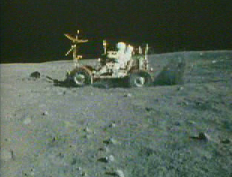 |
 |
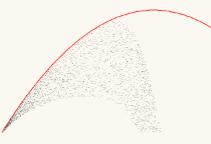 |
| 1-3. The dust cloud on these Apollo 16 lunar rover photos is not of a parabolic shape. 4. Although each particle on the plot follows a parabolic trajectory, the overall shape of the dust cloud deviates strongly from the parabolic shape. Note that the simulation does not attempt to mimic the exact shape of the dust cloud, it merely shows that a complex, unexpected pattern may emerge from simple laws. | |||
2. National Geographic Examination
In 2009, the National Geographic Society examined eight conspiracists based on photographs. Their analysis is titled "Photos: 8 Moon-Landing Hoax Myths – Busted".
- Flags waving
- No photographers
- No stars
- No landing crater
- Lighting varies
- Footprints too clear
- No leftovers visible
- Strange lights
References
- Kaysing 2002, pp. 20, 21, 22, 23
- "First Flight Shrine: Colonel Yuri A. Gagarin". Kitty Hawk, NC: First Flight Society. http://www.firstflight.org/shrine/gagarin.php. Retrieved May 17, 2013.
- The Guardian International space station time lapse https://www.theguardian.com/science/video/2015/jun/23/earth-international-space-station-timelapse-video
- Plait 2002, pp. 158–160
- Keel, William C. (July 2007). "The Earth and Stars in the Lunar Sky". Skeptical Inquirer (Amherst, NY: Committee for Skeptical Inquiry) 31 (4): 47–50.
- Lunsford, Danny Ross; Jones, Eric M. (2007). "Venus over the Apollo 14 LM". Apollo Lunar Surface Journal. NASA. http://www.hq.nasa.gov/alsj/a14/a14Venus.html. Retrieved July 20, 2009.
- Nathans 1989
- Windley, Jay. "Clavius: Bibliography - bart sibrel's top fifteen". Clavius.org. http://www.clavius.org/bibsibrel.html. Retrieved May 16, 2013.
- Woods 2008, pp. 206–207
- Plait 2002, pp. 167-168
- Plait 2002, p. 168
- Windley, Jay. "Clavius: Photo Analysis - terrain and shadow". Clavius.org. http://www.clavius.org/trrnshdow.html. Retrieved December 29, 2008.
- Plait 2002, pp. 167–172
- Colin Rourke (January 14, 2010). "Hadley: a study in fakery (version 2)" (PDF). London: AULIS Publishing. http://www.aulis.com/pdf%20folder/hadley_study.pdf. Retrieved July 15, 2012.
- Rourke, Colin. "Hadley: a study in fakery (version 2) Colin Rourke". Washington, D.C.: United States Department of Energy. http://www.osti.gov/eprints/topicpages/documents/record/635/1511940.html. Retrieved May 16, 2013.
- Windley, Jay. "Clavius: Photo Analysis - converging shadows". Clavius.org. http://www.clavius.org/a11rear.html. Retrieved May 16, 2013.
- Plait 2002, p. 168–169
- Bennett & Percy 2001, p. 66
- Plait 2002, p. 170
- Plait 2002, pp. 169–170
- Windley, Jay. "Clavius: Photo Analysis - buzz's hot spot". Clavius.org. http://www.clavius.org/bootspot.html. Retrieved December 29, 2008.
- "'That may have been a small one for Neil...'". Apollo Lunar Surface Journal. NASA. 1995. http://www.hq.nasa.gov/alsj/a12/a12.eva1prelim.html. Retrieved May 19, 2013. In the transcript, the two quotes, separated by a few minutes, can be compared with RealAudio video clips a12v.1152124.rm and a12v.1152355.rm, which are available on the page.
- Bennett & Percy 2001, p. 27
- Windley, Jay. "Clavius: Photography - crosshairs". Clavius.org. http://www.clavius.org/photoret.html. Retrieved May 16, 2013.
- "Cross Hairs". Redzero.demon.co.uk. Archived from the original on December 19, 2008. https://web.archive.org/web/20081219190825/http://www.redzero.demon.co.uk/moonhoax/Cross_Hairs.htm. Retrieved May 16, 2013.
- White, Jack. "Jack White's Studies – Apollo 12 File". London: AULIS Publishing. Archived from the original on February 4, 2012. https://web.archive.org/web/20120204195240/http://www.aulis.com/jackstudies_9.html. Retrieved December 29, 2008.
- "Apollo 15 Surface Operations Overview". Lunar and Planetary Institute. http://www.lpi.usra.edu/lunar/missions/apollo/apollo_15/surface_opp/. Retrieved May 30, 2013.
- Goddard, Ian Williams (February 26, 2001). "Goddard's Journal: Are Apollo Moon Photos Fake?". http://www.iangoddard.com/moon01.htm. Retrieved December 29, 2008.
- Bara, Michael; Troy, Steve. "Who Mourns For Apollo? Part II" (PDF). LunarAnomalies.com. http://www.studyphysics.ca/apollo2.pdf. Retrieved May 21, 2013. Part I with Steve Troy and Richard C. Hoagland is available here (PDF). Part III by Steve Troy has been archived from the original by the Wayback Machine on June 10, 2009.
- Young, Andrew T.. "Distance to the Horizon". San Diego State University. http://mintaka.sdsu.edu/GF/explain/atmos_refr/horizon.html. Retrieved May 16, 2013.
- White, Jack (2005). "The skeleton in NASA's spacesuit". London: AULIS Publishing. http://www.aulis.com/skeleton.htm. Retrieved May 20, 2013.
- "Apollo Image Atlas, 70mm Hasselblad Image Catalog". Lunar and Planetary Institute. http://www.lpi.usra.edu/resources/apollo/catalog/70mm/magazine/?40. Retrieved May 21, 2013. Apollo 11, Magazine S, images AS11-40-5844 to AS11-40-5970.
- Windley, Jay. "Clavius: Bibliography - the Milne article". Clavius.org. http://www.clavius.org/bibmilne.html. Retrieved May 30, 2013. Original source for Ralph René's viewpoints is an article by journalist David Milne, "Did Man Really Land on the Moon?" (The Big Issue nr. 108 (Scotland edition), reprinted with permission of author).
- Windley, Jay. "Clavius: Photography - image quality". Clavius.org. http://www.clavius.org/photoqual.html. Retrieved May 16, 2013.
- "Where We Are Now: Developments in 2003". London: AULIS Publishing. http://www.aulis.com/apollo-investigation-2003.htm. Retrieved December 29, 2008.
- Windley, Jay. "Clavius: Photo Analysis - lunar rover". Clavius.org. http://www.clavius.org/rover1.html. Retrieved May 21, 2013.
- Bennett & Percy 2001, pp. 321
- Bennett & Percy 2001, pp. 319–320
- Windley, Jay. "Clavius: Bibliography - una ronald and the coke bottle". Clavius.org. http://www.clavius.org/bibcoke.html. Retrieved May 16, 2013.
- Sarkissian, John M. (2001). "On Eagle's Wings: The Parkes Observatory's Support of the Apollo 11 Mission". Publications of the Astronomical Society of Australia (Collingwood, Victoria: CSIRO Publishing for the Astronomical Society of Australia) 18 (3): 287–310. doi:10.1071/AS01038. Bibcode: 2001PASA...18..287S. http://www.parkes.atnf.csiro.au/news_events/apollo11/tv_broadcasts.html. Retrieved December 29, 2008. October 2000 website version, part 10 of 12: "The Television Broadcasts." Original version available from CSIRO Parkes Observatory (PDF).
- O'Neal, James E. (April 12, 2006). "The Videotape Recorder Turns 50". New York: NewBay Media. Archived from the original on April 17, 2006. https://web.archive.org/web/20060417131501/http://tvtechnology.com/features/news/2006.04.12-n_the_video_tape_02.shtml. Retrieved May 16, 2013.
- Sarkissian, John M.. "Highlights from the Television Broadcasts". CSIRO Parkes Observatory. http://www.parkes.atnf.csiro.au/apollo11/tv_highlights.html. Retrieved December 29, 2008.
- Windley, Jay. "Clavius: Photo Analysis - kick the bottle". Clavius.org. http://www.clavius.org/cokebottle.html. Retrieved May 16, 2013.
- O'Dea, Joseph. "a11v_1101342.mpg" (MPEG video). Apollo Lunar Surface Journal. NASA. http://www.hq.nasa.gov/office/pao/History/alsj/a11/a11v_1101342.mpg. Retrieved May 21, 2013. Context page: Apollo 11 Video Library; Journal Text: 110:13:42 [July 20, 1969].
- Mr. Barrett is also a member of Canberra Skeptics. http://www.canberraskeptics.org.au/
- Bennett & Percy 2001
- Bennett & Percy 2001, pp. 319
- Anthony, James. "Fly Me to the Moon". Web Wombat. Web Wombat Pty Ltd. http://www.webwombat.com.au/careers_ed/education/fly-to-moon.htm. Retrieved May 16, 2013.
- Sanner, Howard (October 29, 1995). "Chronology of Ampex Professional Products". http://www.recordist.com/ampex/docs/histapx/ampchrn.txt. Retrieved May 16, 2013.
- Shepard & Slayton 1994
- Windley, Jay. "Clavius: Bibliography - aulis speaks out". Clavius.org. http://www.clavius.org/bibaulis2003.html. Retrieved May 16, 2013.
- Shepard & Slayton 1995
- "EVA-2 Closeout and the Golf Shots". Apollo Lunar Surface Journal. NASA. 1995. http://www.hq.nasa.gov/alsj/a14/a14.clsout2.html. Retrieved May 20, 2013.
- "Did man really walk on the Moon ???". http://www.salagram.net/MoonLandingHoax.htm. Retrieved May 16, 2013.
- Skyzinski, Rich (January–February 1996). "Of Two Worlds". Golf Journal. http://www.usgamuseum.com/about_museum/news_events/news_article.aspx?newsid=157. Retrieved May 20, 2013.






